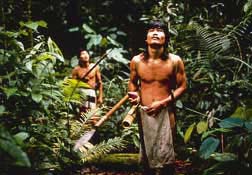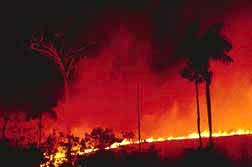
A tropical rainforest is one of the earth's most spectacular natural wonders!
Q: Where can you find tropical rainforests?
A: Tropical rainforests are located around the equator-from the Tropic of Cancer in the north, to the Tropic of Capricorn in the south. The largest rainforests are in Brazil (South America), Zaire (Africa) and Indonesia (islands found near the Indian Ocean). Other tropical rainforests lie in Southeast Asia, Hawaii and the Caribbean Islands. The Amazon rainforest in South America is the world's largest, covering an area about two-thirds the size of the continental United States.
Q: Why are they called "rainforests?"
A: Because they're wet! Tropical rainforests are defined by their wet and dry seasons. Tropical rainforests receive 160 to 400 inches (400-1000) cm) of rain each year. Compare this with the city of Los Angeles, which only receives an average of 10-20 inches of rain a year! Also because rainforests lie near the equator, temperatures stay near 75-80 degrees Fahrenheit all year-round.
Q: What does a rainforest look like?
 A:
Picture yourself walking on a thin carpet of wet, rotting
leaves. If you looked up you would see an umbrella of dark
green leaves. Only a spot or two of blue sky would peek
through the thick mass of tree branches and leaves. You
would also see beautiful flowers growing wild upon the
trees, as well as on the ground. You would hear the constant
sound of insects, birds, and falling twigs. In some
rainforests, you might hear the sounds of large animals like
the gorilla or jaguar.
A:
Picture yourself walking on a thin carpet of wet, rotting
leaves. If you looked up you would see an umbrella of dark
green leaves. Only a spot or two of blue sky would peek
through the thick mass of tree branches and leaves. You
would also see beautiful flowers growing wild upon the
trees, as well as on the ground. You would hear the constant
sound of insects, birds, and falling twigs. In some
rainforests, you might hear the sounds of large animals like
the gorilla or jaguar.
There are so many species of plants and animals in the rainforest that, if you stood in one place and turn a complete circle, you might see hundreds of different species. This incredible number of species of living things is one of the major differences between tropical rainforests and the forests of North America.
A tropical rainforest consists of four layers: the emergent trees, canopy, the understory, and the forest floor. The emergent and canopy layers make up the very top of the rainforest, where a few trees, called emergents, poke out above the green growth to reach the sun. Most of the plant growth is here in the sun, so most rainforest animals, including monkeys, birds and tree frogs, live in the canopy.
Below the canopy are the young trees and shrubs that make up the understory. The plants in this layer rarely grow to large sizes because the canopy blocks most of the sunlight. The forest floor is almost bare because very little light can get through the canopy and understory to the ground. This is where fallen leaves and branches rot quickly to release nutrients for other plants to grow. Large mammals such as South American tapirs and Asian elephants who are too heavy to climb up into the canopy layer live in the dim light of the understory and forest floor.
Q: How do rainforest plants and animals depend on each other?
A: In all of nature, and especially in rainforests, plants and animals depend on each other for survival. This is called interdependence. For example, some insects can only survive in one type of tree, while some birds only eat one type of insect. If this tree is destroyed, the insects will have no home. If these insects die, the birds who rely on them for food will starve to death. Because of this interdependence, if one type of plant or animal becomes extinct, several others could be in danger of extinction as well.
Q: What is the secret to making this system work?
A: One secret to this lush environment is that the rainforest reuses almost everything that falls to the ground and decays. When leaves fall from the trees, when flowers wilt and die, and when any animal dies on the forest floor - it decays and all of the nutrients in the decayed species are recycled back into the roots of the trees and plants.
Only the top few inches of the rainforest soil has any nutrients. Most of the nutrients are in the biomass, the bulk of animal and plant life above the ground. The roots of the rainforest trees are not very deep; that way they can collect all of the nutrients in the top few inches of the soil.
Rainforests even recycle their own rain! As water evaporates in the forest it forms clouds above the canopy that later fall as rain.
 Q:
How do humans depend on rainforests?
Q:
How do humans depend on rainforests?
A: Rainforests are essential-not just to those who live in or near them, but to everyone on the whole planet. They help control the world's climate. However, when the rainforests are burned and cleared, carbon is released that causes the weather to be much hotter. (this is called the greenhouse effect)
People also use many rainforest materials. Many of our medicines come from plants that grow in rainforests. Perhaps someday the cure for cancer or AIDS will be found in a tropical rainforest. Some of the medicines we now use come from tropical rainforest plants, such as aspirin, heart disease treatment and painkillers.
Many products, such as medicines and Brazil nuts, can be taken from rainforests without destroying them; but other products-such as timber, gold, and oil-require a more destructive method of extraction. Logging for tropical timber and gold mining have contributed to much of the destruction of tropical rainforests.
Q: Do people live in rainforests?
A: Indigenous, or native peoples have lived in tropical forests for thousands of years. They use every part of the forest in a sustainable manner, or in a way that does not destroy the forest. Recently, many other people have moved to tropical rainforests, but have used the forests in ways that destroy them.
 Q:
Can rainforests grow back once they have been
destroyed?
Q:
Can rainforests grow back once they have been
destroyed?
A: A rainforest cannot be replaced. Once it has been destroyed it will be gone forever. Once the web of interdependence has been broken, plants and animals have no way to rebuild their complex communities.
Rainforests have been evolving for 70 to 100 million years. They contain plants and animals that live nowhere else on earth. When a rainforest is destroyed, so are the plants and animals who have lived there for millions of years. Once they are destroyed, they will only be memories of our past - unless we help to preserve them now!
Glossary
Biomass: Living and dead matter produced, including plants and animals.
Canopy: The highest layer of the rainforest, made up of the tops of trees. Animals such as howler monkeys, red-eyed tree frogs, sloths and parrots live here.
Equator: An imaginary circle around the earth, equally distant at all points from the North and South poles. It divides the earth into two halves - the Northern and Southern Hemispheres.
Emergent: The tops of the tallest trees in a rainforest.
Evaporate: When moisture changes from liquid to gas in the air.
Extraction: To remove something (for example, to take out Brazil nuts from the Amazon rainforest).
Forest Floor: The ground layer, made up of tree roots, soil and decaying matter. Mushrooms, earthworms, and elephants all make their homes here.
Greenhouse Effect: The warming of the planet caused by chemicals which trap heat in the air. This process is being sped up by humans who put too many heat-trapping chemicals into the air. Some causes include car exhaust, factory smoke, and burning rainforests.
Interdependence: The concept that everything in nature is connected to each other, and cannot survive without the help of other plants, animals and abiotic factors (such as sun, soil, water and air) around it.
Nutrients: Food needed for growth by living things.
Species: A distinct kind of plant or animal that has many common characteristics or qualities.
Sustainable: Using products of the forest in a way that does not permanently destroy them, so that people in the future can also use them.
Tropic of Cancer: A circle around the earth, parallel and to the north of the equator.
Tropic of Capricorn: Similar to the Tropic of Cancer, but to the south of the equator.
Understory: The second layer of rainforests, made up mostly of young trees and shrubs. Animals that live here include jaguars, tapirs, fer-le-lance snakes, and woodpeckers.